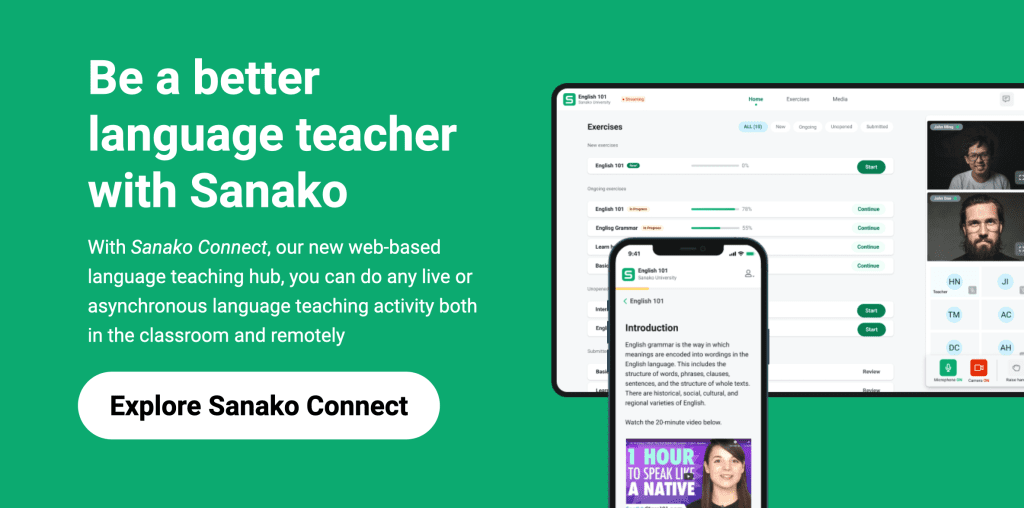Although the Covid-19 pandemic affected almost every element of our lives over the years 2020-2022, its impact on informal online language learning has largely been positive and significant. It’s clear from a variety of sources that as governments introduced lockdown measures, global online language learning activity increased. Indeed, according to the 2020 Duolingo Language Report, over 30 million new people started learning a language on the site when the pandemic started. Technology is increasingly reshaping the way languages are learnt.
This report (and other sources) provide a fascinating insight into learners’ motivation for studying a new language, the languages they’re choosing, and how/when they choose to learn. This blog post will look at some of the most significant top-level trends in online language learning as well as exploring the implications and opportunities for the formal language learning sector.
1. A surge in the number of new language learners
Along with other favourite lockdown activities like bingeing on Netflix, streaming music/videos, and creating TikToks, the world has flocked to language learning apps in unprecedented numbers. Globally, Duolingo reported that 30 million new learners began studying a language from March to April 2020 – that’s 67% more than in the same period in 2019. Similarly, Busuu reported that its active global user numbers tripled in 2020 with Babbel also noting a 50% worldwide increase in user registrations.
2. Learner motivation
It’s also interesting to look at what inspired new learners to begin their language learning journeys. The evidence from Duolingo is clear with nearly 30% reporting that their motivation was to help with school work – only 22.6% gave that rationale when signing up in March/April of 2019. Brain training and mental stimulation came a distant second, accounting for only 15.9% of all new learners.
Although only 12.7% of new learners told Duolingo that they were learning a new language in anticipation of international travel, research by culturetrip found that lockdowns did stimulate a strong correlation between language learning and interest in travel. Their research showed that people in the UK searched online for hotels in Spain at the same time as searching how to learn Spanish. Similarly, long-term data from the United States found that Americans started learning Spanish 11 weeks almost to the day after they had booked a hotel in Mexico. A trip to Mexico certainly sounds good after all this time at home!
3. English, French, and Spanish lead the way
The Duolingo report is also illuminating when we look at which languages are studied across the world and there’s a significant change since their last report in 2016.
Unsurprisingly, Duolingo reports that English remains the most popular language to study globally. It’s the top language being studied in 121 countries, cementing its position as the global language and the one most commonly used in multilingual environments and communities.
Spanish and French make up the top three, but Spanish has risen to claim the number 2 spot in the last four years. Spanish is now rated the most popular language to study in 34 countries, while French is now the top choice in only 23 countries globally, according to the Duolingo survey. Much of that shift can be attributed to learner motivations including family and travel, particularly given the increasing movement of people between Latin America and the rest of the world.
4. Rising Asia
The other hugely significant global trend identified in the Duolingo report is that all five of the world’s fastest-growing languages (Hindi, Korean, Japanese, Turkish, and Chinese) are Asian. As the report notes: “While the languages themselves are extremely linguistically diverse (all five come from completely different language “families”), what they have in common is that they are spoken by communities that have a growing presence in media and pop culture worldwide.”
Japanese and Korean have, in particular, been increasingly popular languages to study globally in recent years.
Driven by Tokyo hosting the next Olympics and growing international interest in Japanese culture, such as manga and anime, Japanese is now the third-fastest growing language globally. It’s also the 6th most popular language to study around the world – there are now nearly as many people learning Japanese as there are learning traditional favourites such as Italian.
Korean is the second-fastest-growing language in the world and is globally rated as the seventh most popular language to study. Its rapid growth in popularity can be attributed to the increasing popularity of Korean culture around the world – undoubtedly the success of Parasite at the 2020 Oscars and the exceptional global power of K-pop acts, such as BTS boyband (nearly 40m followers on Instagram), have played a significant role.
5. When do they study?
The final notable global trend identified in the Duolingo report is that evening is clearly the most popular time for learners to sit down and study. Duolingo’s report shows that learners in half of all countries surveyed are most active from 10-11 pm and learners in another +40% of countries are most active between 9-10 pm.
What does this mean for formal language teaching and learning?
At the time of writing, most language teaching globally was still delivered at a distance. However, after we finally emerged from the pandemic, it’s fair to assume that people are again looking for more social interaction and a return to face-to-face teaching is a key part of that.
Yet it’s also clear, in both formal and informal language teaching settings, that a fundamental shift has occurred. As outlined above, many people have had the (enforced) opportunity to explore online language learning in the last year and the flexibility, convenience, and gamified engagement will better suit some people’s learning and lifestyles moving forward. Online language teaching and learning will therefore continue to play a key role as life returns to “normal” – the opportunity is now with education institutions to develop curricula and content that captures the attention of these new language learners for the long term.
One potential way to do this is to highlight the value-added and improved outcomes generated through teacher-led language education. Clearly, there are benefits to self-learning models, but it can be hard to maintain motivation as well as challenging to find opportunities to realistically practise and master speaking/listening skills. Such scenarios are, of course, where the teacher plays a key role and where language learning institutions (whether face-to-face or online) have the biggest role to play and opportunity to grow.
With customers in 114 countries and +50,000 classrooms, Sanako is well-positioned to support such educational institutions as they respond to this challenge. Sanako’s Connect product is, for example, a powerful web-based language teaching hub for schools and universities – it supports the fullest range of digital teaching approaches and enables students to engage anytime, anywhere. Most importantly, Connect supports all students in a cohort to do speaking and conversation practice at the same time and provides a powerful platform for educators to assess progress, create/share learning resources and provide feedback.
If you’d like to find out more about Sanako’s language teaching software solution, click the button below to learn more and book your free remote demo!
This blog post was last updated 4 May, 2023.

